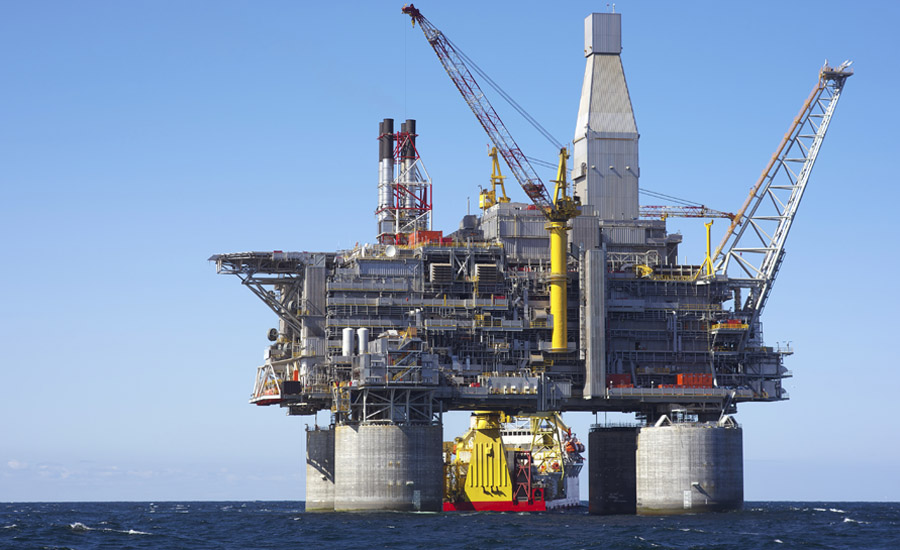Oil rigs remain among the most impressive feats of modern engineering. These are the vast offshore structures that operate in some of the harshest environments on Earth to power global energy needs. From towering deep-water platforms to semi-submersible giants, these installations go to demonstrate both the scale of offshore exploration and the technology that underpins it. They have however become an issue of contention in the wake of climate change and action.
Before looking at the top 6 largest oil rigs in the world and the stories behind them, let’s look at the features used to assess the mega structures that mark milestones in capabilities of offshore energy production.
Features to Consider in Assessing the World’s Largest Oil Rigs
The size of the largest oil rig in the world can be measured by the following factors:
- The height of the platform, (not including the base). Also referred to as topsides.
- The total weight of the oil rig inclusive of the base and the moorings located underwater.
- Barrel of Oil Equivalent (BOE). This is the amount of energy released by burning one barrel of crude oil. 1 BOE is approx. 5.8 million British Thermal Units (MMBtu), or 1,700 kilowatt-hours (kWh) of energy.
- The maximum number of barrels the oil rig can produce in a single day when assuming ideal production conditions.
1 barrel is equal to 42 U.S. gallons, or 158.9 liters.
1. Berkut Oil Rig – Russia
Location: Sea of Okhotsk
Constructed at a cost of $12 billion, the 220,000 tonnes Berkut Oil Platform, also known as The Golden Eagle, is the largest oil rigs in the world in terms of weight.
This oil platform was set up in one of the most remote and hostile water bodies on Earth. It is designed to withstand waves of up to 59 ft (18 m), temperatures as low as -44 degrees Celsius, and strong ice floes. Additionally, its underwater base consists of 53,000 cubic meters of concrete and 27,000 of steel structure. The topsides of this rig sit at a depth of 115 ft (35 m) and reach heights of 475 ft (145 m). Additionally, they weigh more than 42,000 tonnes.
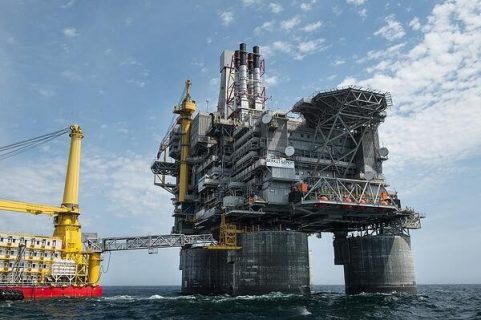
The Exxon-operated oil platform has a production capacity of over 45,000 barrels per day. The Berkut Oil Platform is owned by ExxonMobil affiliate, Exxon Neftegas Limited (ENL), and Sakhalin Oil and Gas Development Co.
2. Hibernia Oil Platform – Canada
Location: Jeanne d’Arc Basin, North Atlantic Ocean
Located in the North Atlantic ocean and approximately 195 miles (315 km) on the east-southeast of Newfoundland in Canada, Hibernia oil rig is the offshore platform designed to resist iceberg impacts. It’s base can also store 1.3 million barrels of oil, making it one of the largest rigs in the world.
Its topsides which weigh 37,000 tonnes are mounted on a colossal gravity base structure that weighs about 600,000 tonnes. Additionally, the gravity-base structure sits 262 ft (80 m) deep into the North Atlantic waters.
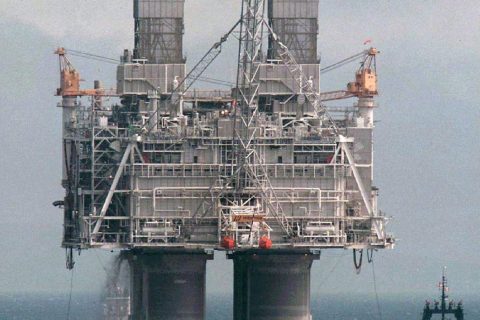
Hibernia oil rig started operating in 1997. The serrated and star-shaped oil platform also operates on a field with approximately 1.4 billion barrels of oil.
3. Perdido – U.S.
Location: Gulf of Mexico
Perdido is a Spanish term that translates to lost. The Shell-operated oil platform is the deepest in the world with is massive cylindrical hull being as tall as the Eiffel Tower. It is also moored around 2,450 meters of water.
Located about 320 miles (515 km) south of Galvestone, Texas, its production capacity is at approximated 100,000 barrels of oil and 200 million cubic feet of gas per day.
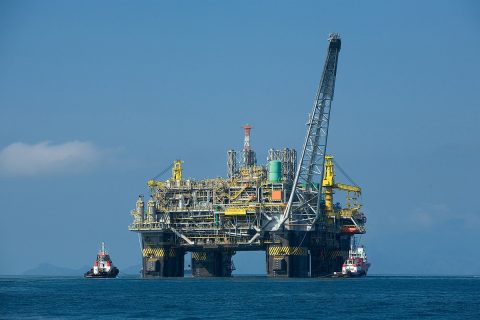
4. Petronius – U.S.
Location: Gulf of Mexico
Petronius oil rig is named after the famous ancient Roman writer, by the same name, who was active during the reign of Emperor Nero.
At 2,100 ft (640 m), Petronius oil platform was once the tallest structure in the world before the construction of the Burj Khalifa in Dubai. It is still taller than most skyscrapers in the world, and the tallest free-standing structure in the world when measured from seabed to top. This makes Petronius the tallest oil rig in the world.
Located 130 miles (210 km) southeast of New Orleans, the compliant-tower-type Petronius also weighs about 45,000 tonnes.
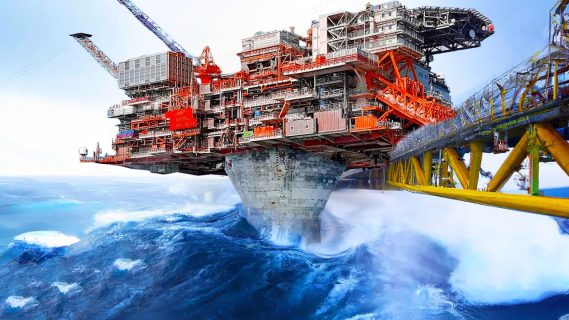
Its compliant tower design also allows it to move in harmony with the swell of the ocean rather than resisting it. This flexibility feature enable this oil platform to yield and sway up to an extent of over 2% of its overall height. By comparison, conventional structures usually limit their swaying ability to not exceeding 0.5% of the overall height.
5. Troll A Oil Rig – Norway
Location: North Sea
Equinor-operated Troll A stands at a staggering height of 1,549 ft (472 m). This makes it the tallest and heaviest structure ever moved by humans. This mega structure is a concrete gravity-base platform. It weighs over 1.2 million tonnes.
Troll A also supplies about 10 per cent of Norway’s natural gas exports and is considered a national engineering symbol of offshore excellence.
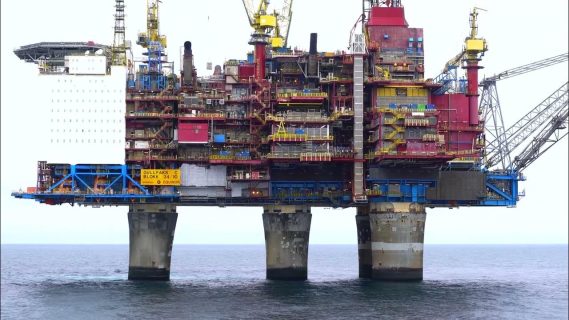
Gullfaks C Oil Platform
Norway also has the Gullfaks C oil platform. It is also one of the largest and heaviest concrete gravity-base structures ever built. With a weight of 1.5 million tonnes, it is heavier than Troll A’s deck. It is however considered older generation compared to Troll, having been installed in 1989. Gullfaks C is also operated by Equinor. It is also noted for its key role in Norway’s offshore oil boom through the Gullfaks field. The oil platform stands at a height of 1,247 ft (380 m) and sits at a water depth of 134 ft (217 m).
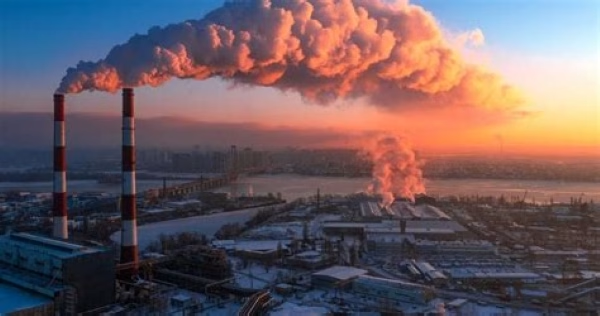
6. Olympus – U.S.
Location: Gulf of Mexico
Named after the highest mountain in Greece, and the home of gods in Greek mythology, Olympus is indeed a competitive contender for the world’s largest oil rid title. It is located in the Mars B oil field and continues to support the field’s development. Mars B is a second phase to extend the life of one of the Shell’s largest producing fields in the Gulf region.
Designed uniquely to withstand harsh sea hurricanes, the tension-leg platform kicked off operations in 2014. Olympus sits 129 miles (209 km) south of New Orleans. It is in more than 3,000 ft (900 m) of water and weighs approximately 109,000 tonnes. It is also able to accommodate about 200 staff members.
Shell’s Olympus produces about 100,000 barrels of oil equivalent (BOE) per day.
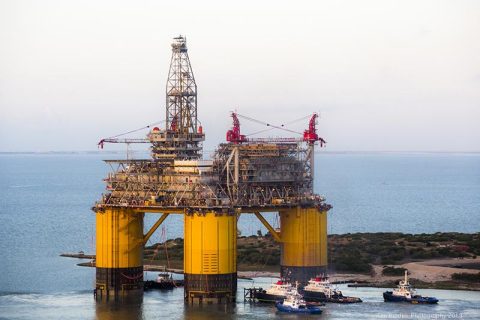
Outlook on the World’s Largest Oil Rigs
Beyond their engineering scale, these rigs also symbolize the evolution of offshore energy from shallow-water steel legs to deepwater floating systems. They have also laid groundwork for the transition toward lower-carbon operations, This is as the same subsea and platform technologies are being adapted for offshore wind, carbon storage, and hydrogen projects. A good example of this is the push by Indonesia to repurpose its oil and gas blocks for carbon storage.
The list of the world’s largest oil rigs has been ranked by overall structural size and engineering significance. This encompassed height and weight of the platforms. Alongside this was also the type of structure implemented in their design and record-setting features. Also looked at was their operational significance and production volume.
Additionally, while the list seems to center on North America and Europe, other continents also continue to play a major role in global oil and gas production. Africa, for instance, has recently seen renewed interest in some of its key oil blocks by energy majors such as TotalEnergies in Liberia. The eastern block of the continent is also advancing groundwork for further technical development on the long awaited Tanzania-Uganda pipeline project that is set to reshape gas access and industrial energy supply in East Africa.
Also read:
